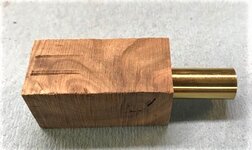David
If I understand correctly, your problem is that a 12.5mm OD tube binds when inserted into a hole drilled with a 12.5mm bit.
There are several things that could cause a hole to be deformed - tailstock wobble is very common on smaller lathes (there are several posts that discuss this problem), but I would think that if the tailstock is wobbling, it is likely that the deformation that would result is that the hole would be slightly conical with the minimum diameter equal to the diameter of the drill bit. And I could visualize a situation where the two ends of a hole would be conical, with the diameter where the two cones intersect equal to the bit diameter. But in either case, I can't see how the ID of the hole could be less than the OD of the drill bit (except for the possibility of shrinkage as discussed below).
So that leads be to speculate about other things that might cause the kind of binding your are experiencing. Two things come to mind. First, have you actually measured the OD of the tube and the diameter of the drill bit using the same measuring instrument? Incidentally, I think most people would agree that you don't want the diameters of the bit and tube to be exactly the same - the diameter of the bit needs to be very slightly greater than the diameter of the tube so that the hole is very slightly oversized, leaving space around the tube for glue.
The second thing I would wonder about is what kind of material are you drilling. If it is wood, drilling will heat the wood, and the heat will drive out moisture causing the wood to shrink. Even so-called 'kiln-dried' wood still contains moisture. I recently made some small end-grain boxes in which I first sized the tenon to match a recess in the top of the box, giving a reasonably snug fit so that the bottom of the box could be used a a jam chuck when shaping the top of the box. Then, I used a drill bit to drill out the body (bottom) of the box, but then found that the tenon that had been a snug fit into the recess had shrunk and had become quite loose. That experience leads me to wonder if it is possible that you problem comes about when the wood dries causing the wood to shrink, forcing the hole to become very slightly smaller.
The third possibility is that the drill bit wandered off axis as you were drilling. Again, this tends to be more common in drilling wood and comes about when the bit is advanced into the wood so rapidly that it flexes and starts following grain lines in the wood. Wood grows faster in the summer than in the winter, so summer-growth wood is softer than winter-growth wood. If the timber you are working with has distinct grain lines, it is possible that the bit deflected resulting in the hole not being absolutely straight. In this instance, the hole can have the correct ID, but the tube will still bind since it can't easily deflect to adapt to the curve in the hole.
Most of the information you read about drilling advises slowing down the lathe (to 300-500 r/min) and withdrawing the bit every so often to remove the buildup of swarf in the flutes in the bit. Friction between compacted swarf in the flutes in the inside lining of the drilled hole can cause more heat that friction between the bit itself and the wood. But I would modify that advice slightly - I favor a slightly higher rotational speed when drilling, but advancing the bit into the wood very slowly (while still periodically withdrawing the bit to clear the swarf). That way, the tip of the bit is actually cutting a hole in the wood on axis with the bit. But if you advance the bit too quickly, you can force the bit to deviate off axis and into that softer summer-growth wood resulting in a bent hole.

